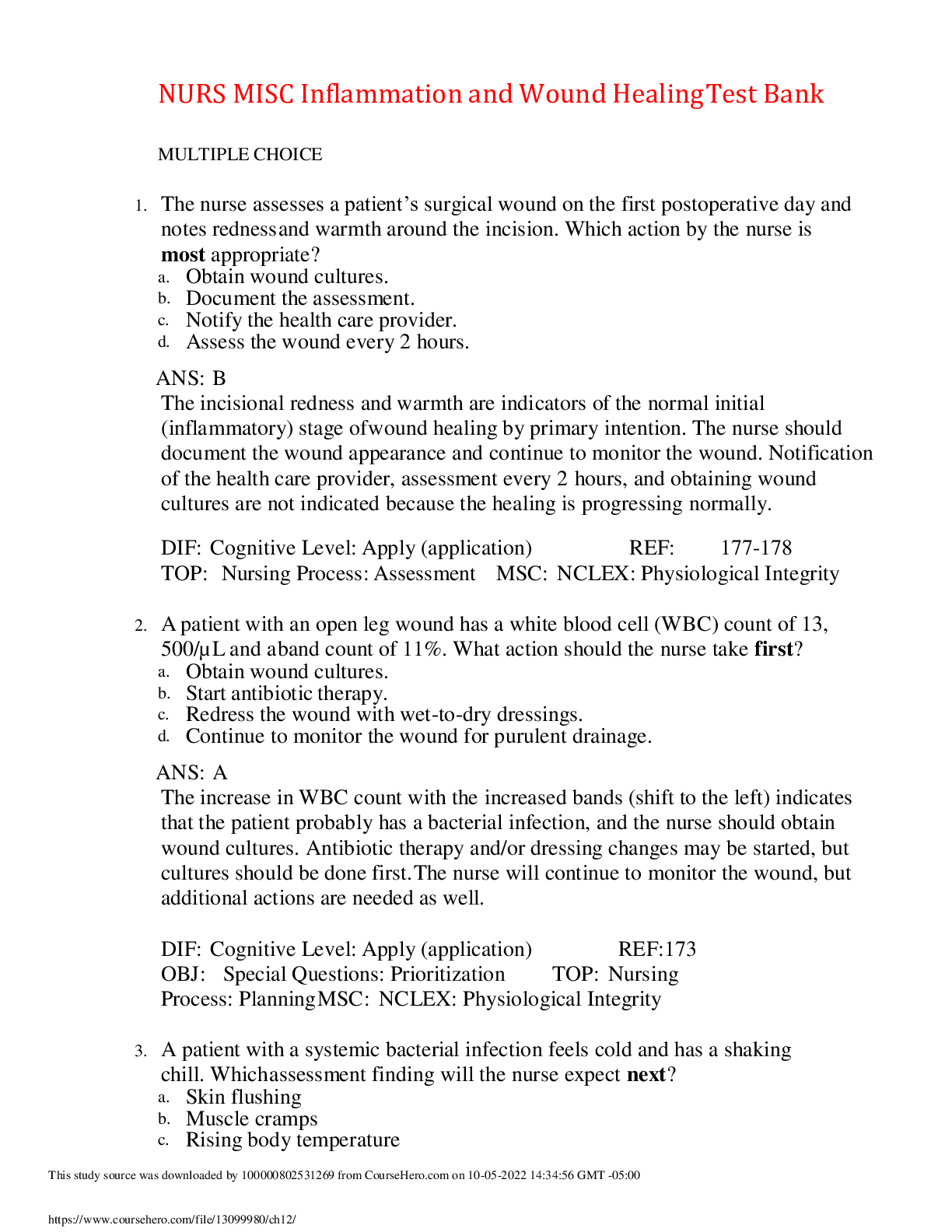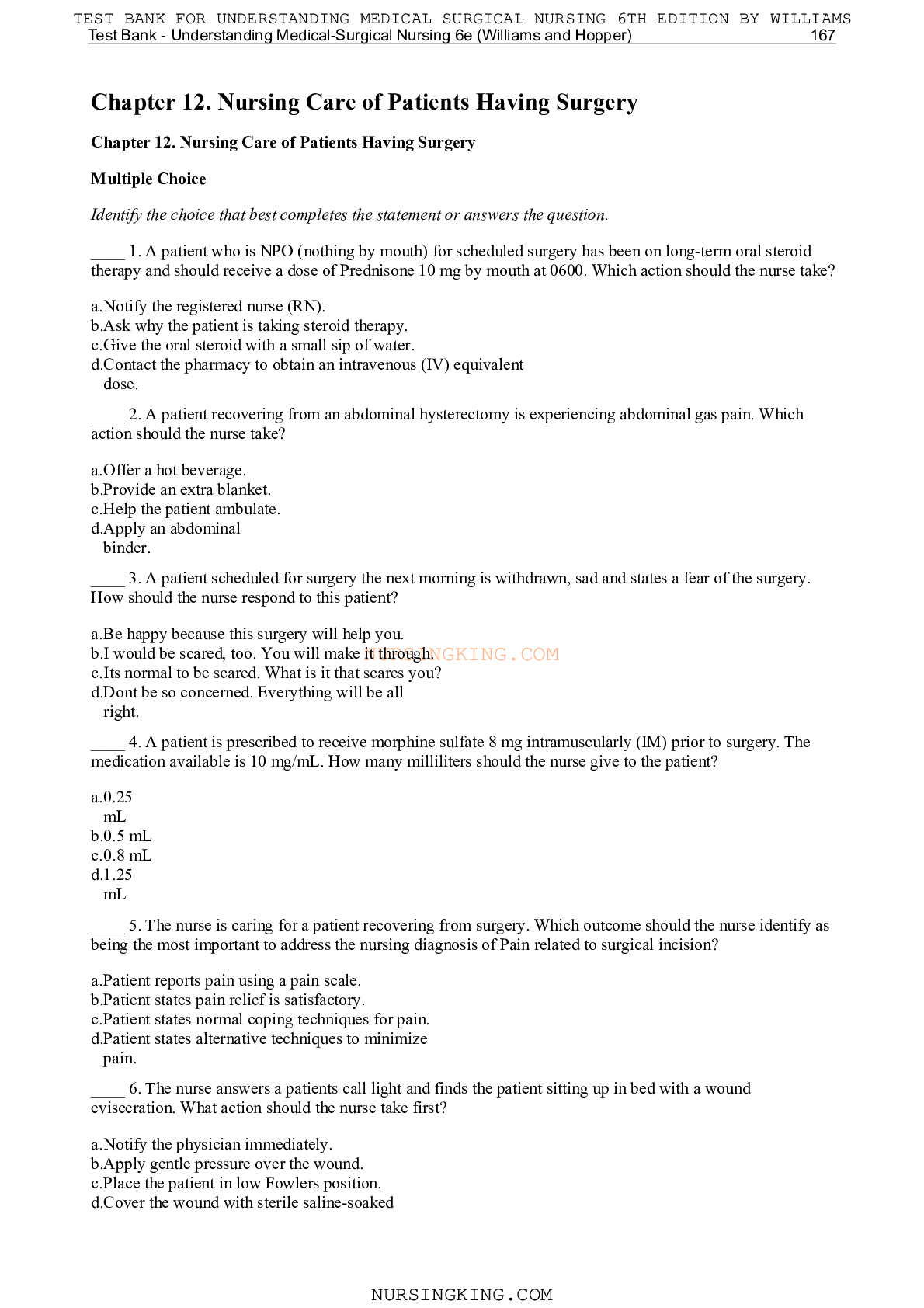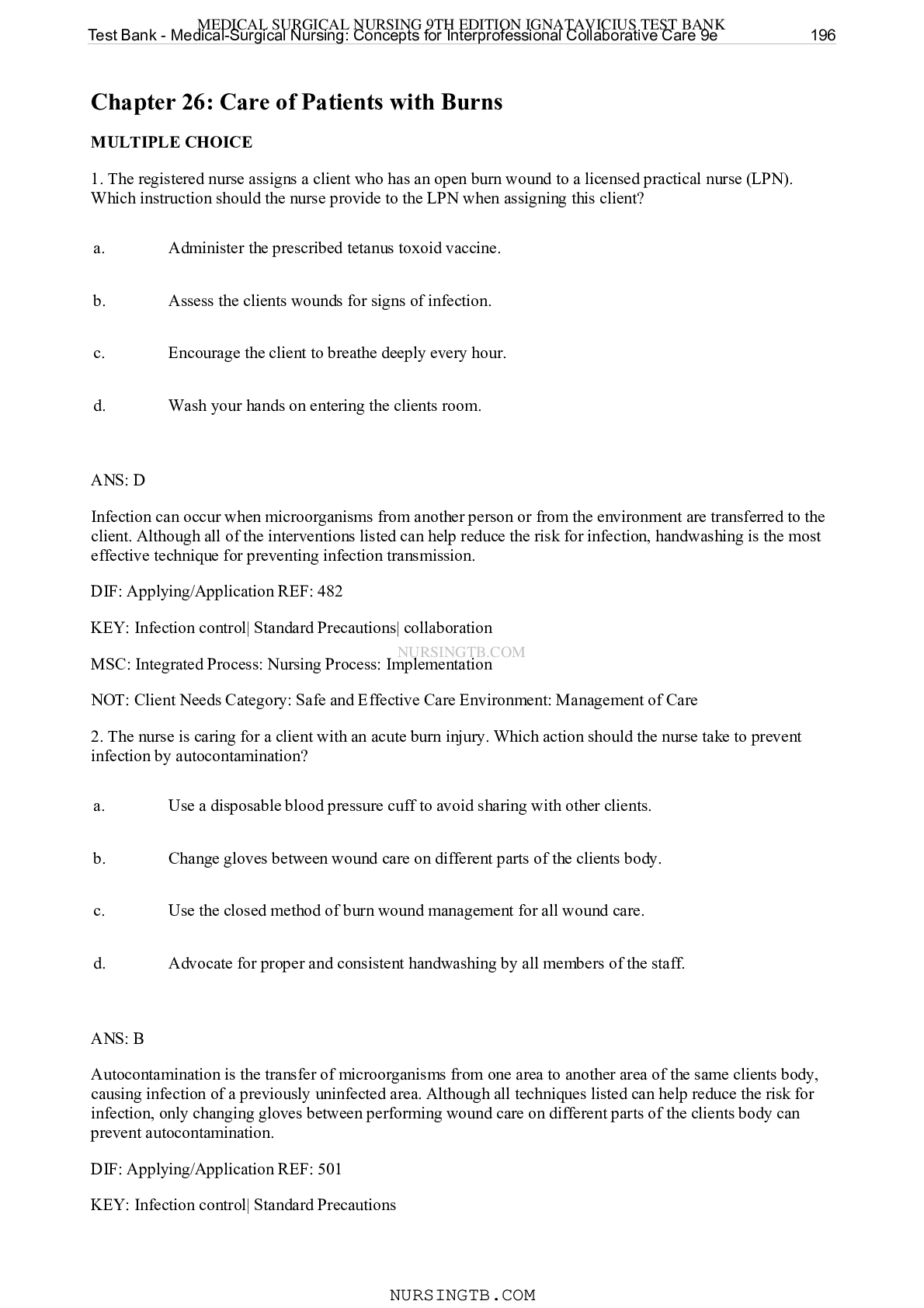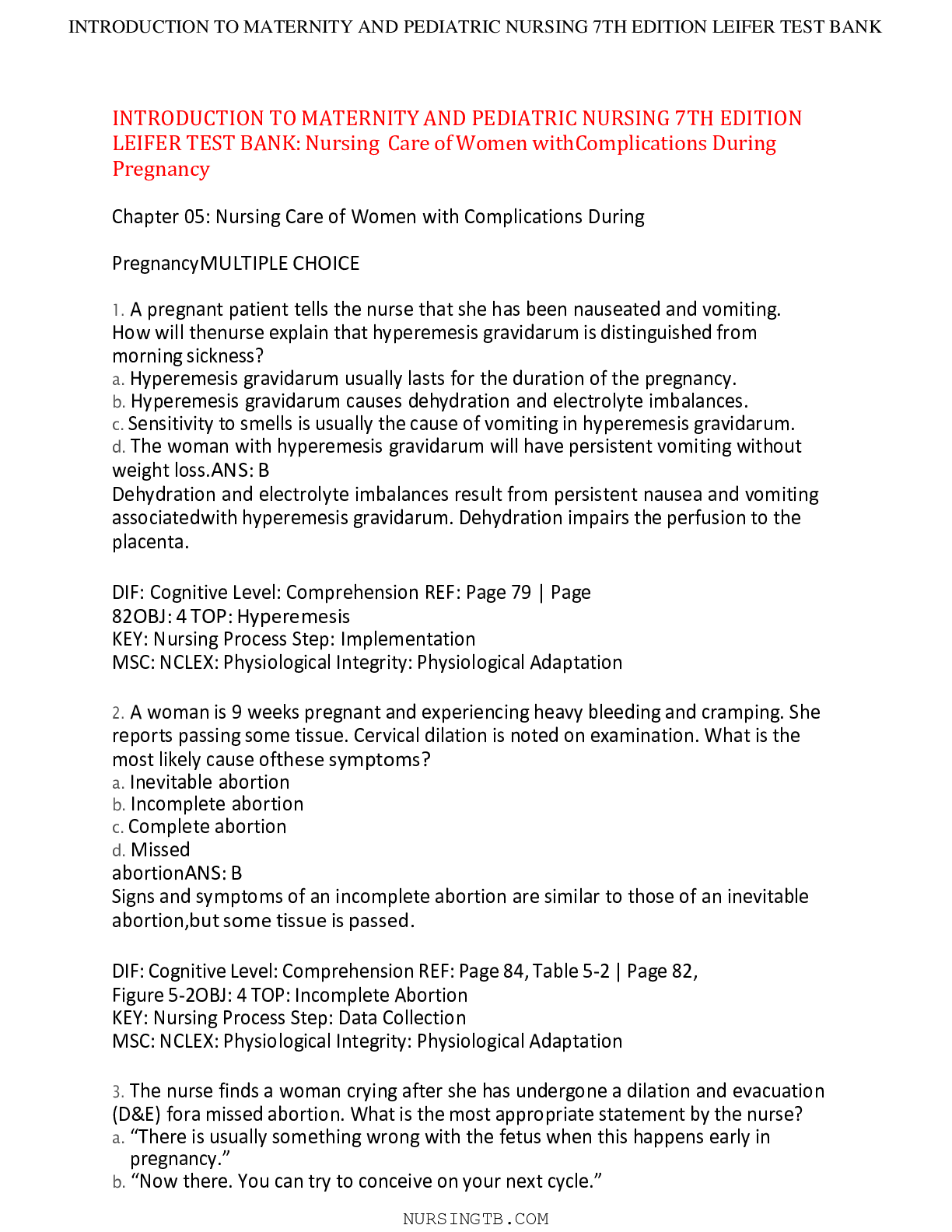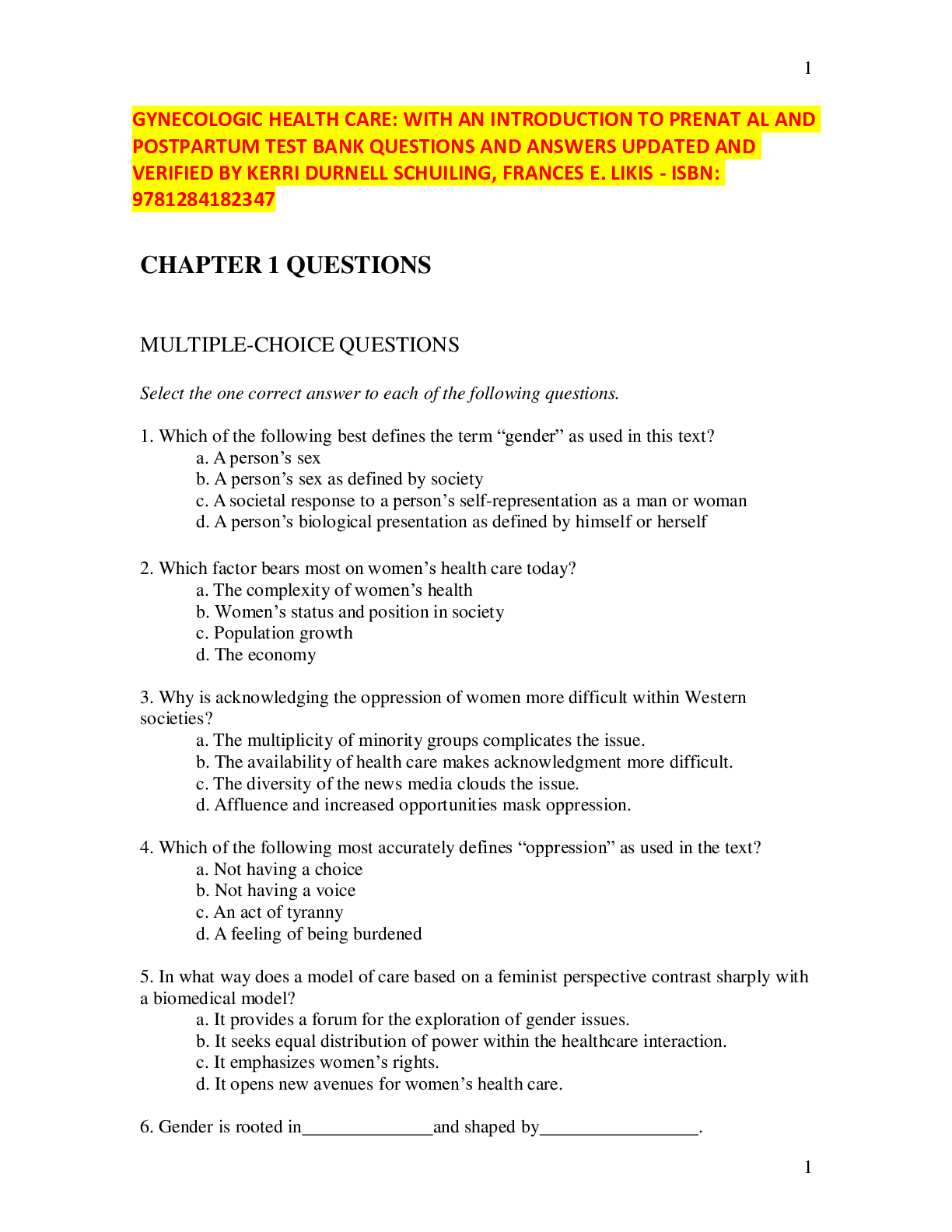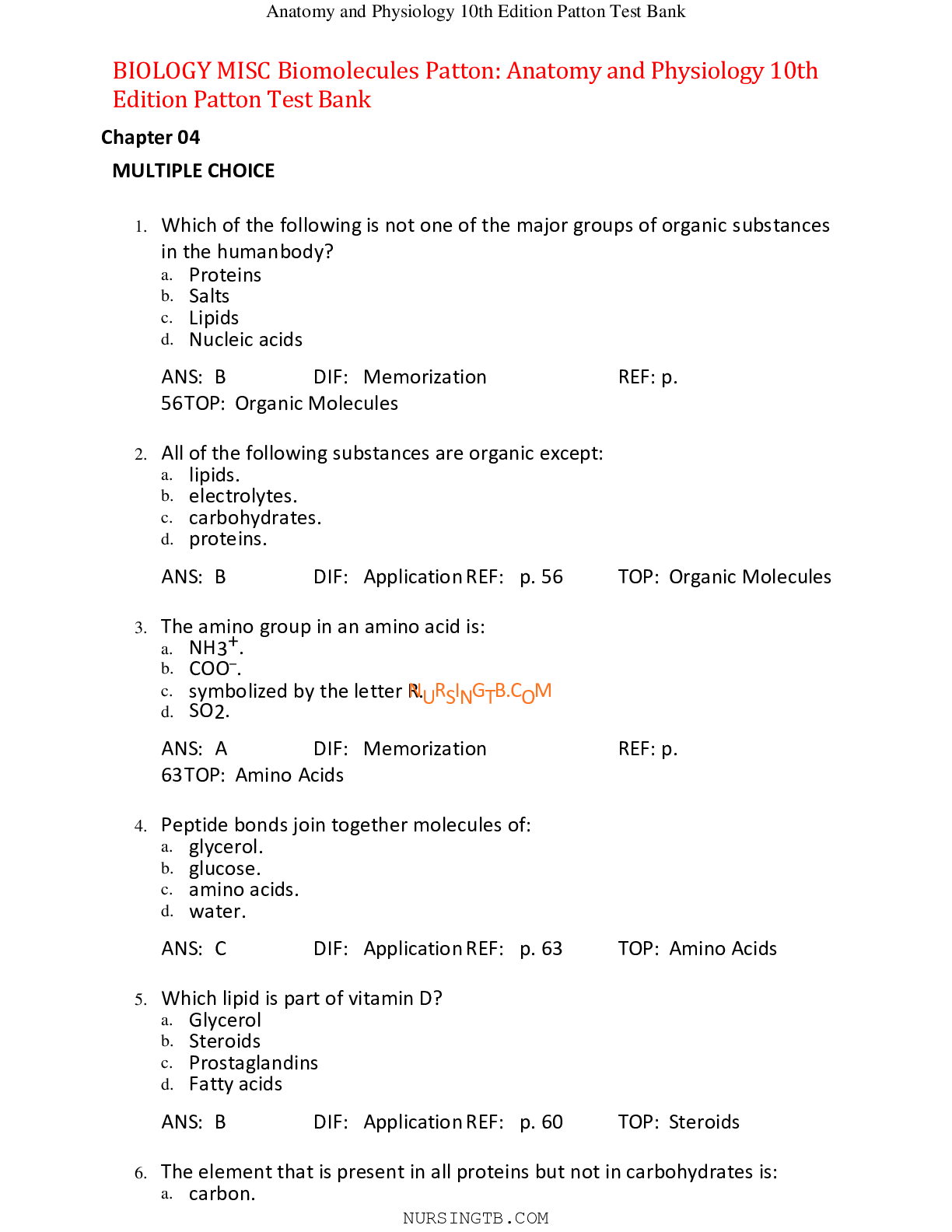*NURSING > TEST BANK > Chapter 44: Care of Patients with Problems of the Central Nervous System: The Brain Test Bank,100% C (All)
Chapter 44: Care of Patients with Problems of the Central Nervous System: The Brain Test Bank,100% CORRECT
Document Content and Description Below
Chapter 44: Care of Patients with Problems of the Central Nervous System: The Brain Test Bank MULTIPLE CHOICE 1. The nurse is caring for a client experiencing migraine headaches who is receiv... ing a beta blocker to help manage this disorder. When preparing a teaching plan, which instruction does the nurse plan to provide? a. “Take this drug only when you have prodromal symptoms indicating the onset of a migraine headache.” b. “Take this drug as ordered, even when feeling well, to prevent vascular changes associated with migraine headaches.” c. “This drug will relieve the pain during the aura phase soon after a headache has started.” d. “This medication will have no effect on your heart rate or blood pressure because you are taking it for migraines.” ANS: B Beta blockers are prescribed as prophylactic treatment to prevent the vascular changes that initiate migraine headaches. Heart rate and blood pressure will also be affected, and the client should monitor these side effects. The other responses do not discuss an appropriate use of the medication. DIF: Cognitive Level: Application/Applying or higher REF: N/A TOP: Client Needs Category: Physiological Integrity (Pharmacological and Parenteral Therapies— Expected Actions/Outcomes) MSC: Integrated Process: Teaching/Learning 2. The nurse is assessing a client with a history of migraines. Which clinical manifestation is an early sign of a migraine with aura? a. Vertigo b. Lethargy c. Visual disturbances d. Numbness of the tongue ANS: C Early warning of impending migraine with aura usually consists of visual changes, flashing lights, or diplopia. The other manifestations are not associated with an impending migraine with aura. DIF: Cognitive Level: Comprehension/Understanding REF: p. 928 TOP: Client Needs Category: Physiological Integrity (Physiological Adaptation—Pathophysiology) MSC: Integrated Process: Nursing Process (Assessment) 3. The nurse is reviewing a client’s prescription for sumatriptan succinate (Imitrex). Which condition in this client’s medical history does the nurse report to the health care provider? a. Bronchial asthma b. Gonorrhea c. Prinzmetal’s angina d. Chronic kidney disease ANS: C Sumatriptan succinate effectively reduces pain and other associated symptoms of migraine by binding to serotonin receptors and triggering cranial vasoconstriction. Vasoconstrictive effects are not confined to the cranium and can cause coronary vasospasm in clients with Prinzmetal’s angina. The other conditions would not affect the client’s treatment. DIF: Cognitive Level: Application/Applying or higher REF: N/A TOP: Client Needs Category: Physiological Integrity (Pharmacological and Parenteral Therapies— Adverse Effects/Contraindications/Side Effects/Interactions) MSC: Integrated Process: Nursing Process (Analysis) 4. The nurse is assessing a client with a cluster headache. Which clinical manifestation does the nurse expect to find? a. Ipsilateral tearing of the eye b. Exophthalmos c. Abrupt loss of consciousness d. Neck and shoulder tenderness ANS: A Cluster headache is usually accompanied by ipsilateral tearing, rhinorrhea or nasal congestion, ptosis, eyelid edema, facial sweating, and miosis. The other manifestations are not associated with cluster headaches. DIF: Cognitive Level: Comprehension/Understanding REF: p. 931 TOP: Client Needs Category: Physiological Integrity (Physiological Adaptation—Pathophysiology) MSC: Integrated Process: Nursing Process (Assessment) 5. A client with epilepsy develops stiffening of the muscles of the arms and legs, followed by an immediate loss of consciousness and jerking of all extremities. How does the nurse document this seizure activity? a. Atonic seizure b. Absence seizure c. Myoclonic seizure d. Tonic-clonic seizure ANS: D Seizure activity that begins with stiffening of the arms and legs, followed by loss of consciousness and jerking of all extremities, is characteristic of a tonic-clonic seizure. The other seizures do not manifest in this manner. DIF: Cognitive Level: Comprehension/Understanding REF: p. 932 TOP: Client Needs Category: Physiological Integrity (Physiological Adaptation—Pathophysiology) MSC: Integrated Process: Communication and Documentation 6. The nurse is assessing a client with a history of absence seizures. Which clinical manifestation does the nurse assess for? a. Automatisms b. Intermittent rigidity c. Sudden loss of muscle tone d. Brief jerking of the extremities ANS: A Automatisms are characteristic of absence seizures. These behaviors consist of lip smacking, patting, and picking at clothing. The other manifestations do not correlate with absence seizures. DIF: Cognitive Level: Comprehension/Understanding REF: p. 932 TOP: Client Needs Category: Physiological Integrity (Physiological Adaptation—Pathophysiology) MSC: Integrated Process: Nursing Process (Assessment) 7. The nurse is caring for a client with a history of epilepsy who suddenly begins to experience a tonic-clonic seizure and loses consciousness. What is the nurse’s priority action? a. Restrain the client’s extremities. b. Turn the client’s head to the side. c. Take the client’s blood pressure. d. Place an airway into the client’s mouth. ANS: B The nurse should turn the client’s head to the side to prevent aspiration and allow drainage of secretions. The client should not be restrained nor an airway placed in his or her mouth during the seizure because these actions increase seizure activity and can harm the client. Vital signs are measured in the postictal phase of the seizure. DIF: Cognitive Level: Application/Applying or higher REF: N/A TOP: Client Needs Category: Physiological Integrity (Reduction of Risk Potential—Potential for Complications from Surgical Procedures and Health Alterations) MSC: Integrated Process: Nursing Process (Implementation) 8. A client is actively experiencing status epilepticus. Which prescribed medication does the nurse prepare to administer? a. Atropine b. Lorazepam (Ativan) c. Phenytoin (Dilantin) d. Morphine sulfate ANS: B Initially, intravenous lorazepam is administered to stop motor movements. This is followed by the administration of phenytoin. Atropine and morphine are not administered for seizure activity. DIF: Cognitive Level: Application/Applying or higher REF: N/A TOP: Client Needs Category: Physiological Integrity (Pharmacological and Parenteral Therapies— Expected Actions/Outcomes) MSC: Integrated Process: Nursing Process (Implementation) 9. A client with new-onset status epilepticus is prescribed phenytoin (Dilantin). After teaching the client about this treatment regimen, the nurse assesses the client’s understanding. Which statement indicates that the client understands the teaching? a. “I must drink at least 2 liters of water daily.” b. “This will stop me from getting an aura before a seizure.” c. “I will not be able to be employed while taking this medication.” d. “Even when my seizures stop, I will take this drug.” ANS: D Discontinuing antiepileptic drugs can lead to the recurrence of seizures or status epilepticus. The client does not need to drink more water and can continue to work while taking this medication. The medication will not stop an aura before a seizure. DIF: Cognitive Level: Application/Applying or higher REF: N/A TOP: Client Needs Category: Physiological Integrity (Pharmacological and Parenteral Therapies— Expected Actions/Outcomes) MSC: Integrated Process: Teaching/Learning 10. The nurse is teaching a client who is newly diagnosed with epilepsy. Which statement by the client indicates a need for further teaching concerning the drug regimen? a. “I will not drink any alcoholic beverages.” b. “I will wear a medical alert bracelet.” c. “I will let my doctor know about all of my prescriptions.” d. “I can skip a couple of pills if they make me ill.” ANS: D The nurse must emphasize that antiepileptic drugs must be taken even if seizure activity has stopped. Discontinuing the medication can predispose the client to seizure activity and status epilepticus. The client should not drink alcohol while taking seizure medications. The client should wear a medical alert bracelet and should make the doctor aware of all medications to prevent complications of polypharmacy. DIF: Cognitive Level: Application/Applying or higher REF: N/A TOP: Client Needs Category: Health Promotion and Maintenance (Self-Care) MSC: Integrated Process: Teaching/Learning 11. The nurse assesses for which clinical manifestations in the client with suspected encephalitis? a. Fever of 101° F (38.3° C) b. Nausea and vomiting c. Hypoactive deep tendon reflexes d. Pain on flexion of the neck ANS: D Nuchal rigidity is associated with meningeal irritation and is frequently present in clients with encephalitis. The other manifestations are not associated with encephalitis. DIF: Cognitive Level: Comprehension/Understanding REF: p. 940 TOP: Client Needs Category: Physiological Integrity (Physiological Adaptation—Pathophysiology) MSC: Integrated Process: Nursing Process (Assessment) 12. The nurse is taking the health history of a client suspected of having bacterial meningitis. Which question is most important for the nurse to ask? a. “Do you live in a crowded residence?” b. “When was your last tetanus vaccination?” c. “Have you had any viral infections recently?” d. “Have you traveled out of the country in the last month?” ANS: A Meningococcal meningitis tends to occur in outbreaks. It is most likely to occur in areas of high-density population, such as college dormitories, prisons, and military barracks. The other questions do not identify risk factors for bacterial meningitis. DIF: Cognitive Level: Application/Applying or higher REF: N/A TOP: Client Needs Category: Health Promotion and Maintenance (Health Screening) MSC: Integrated Process: Nursing Process (Assessment) 13. The nurse is talking to the family of a client who has Parkinson’s disease. Which statement indicates that the family has a good understanding of the changes in motor movement associated with this disease? a. “I can never tell what she’s thinking. She hides behind a frozen face.” b. “She drools all the time so I just can’t take her out anywhere.” c. “I think this disease makes her nervous. She perspires all the time.” d. “She has trouble chewing so I will offer bite-sized portions.” ANS: D A masklike face, drooling, and excess perspiration are common in clients with Parkinson’s disease. Changes in facial expression or a masklike facies in a Parkinson’s disease client can be misinterpreted. Because chewing and swallowing can be problematic, small frequent meals and a supplement are better for meeting the client’s nutritional needs. The other statements indicate poor understanding of the disease process. DIF: Cognitive Level: Application/Applying or higher REF: N/A TOP: Client Needs Category: Psychosocial Integrity (Therapeutic Communication) MSC: Integrated Process: Teaching/Learning 14. The nurse is caring for a client with Parkinson’s disease. Which intervention does the nurse implement to prevent respiratory complications in the client? a. Keep an oral airway at the bedside. b. Ensure fluid intake of at least 3 L/day. c. Teach the client pursed-lip breathing techniques. d. Maintain the head of the bed at 30 degrees or greater. ANS: D Elevation of the back rest will help prevent aspiration. The other options will not prevent aspiration, which is the greatest respiratory complication of Parkinson’s disease. DIF: Cognitive Level: Application/Applying or higher REF: N/A TOP: Client Needs Category: Physiological Integrity (Reduction of Risk Potential—Potential for Complications from Surgical Procedures and Health Alterations) MSC: Integrated Process: Nursing Process (Implementation) 15. The daughter of a client with Alzheimer’s disease asks, “Will the medication my mother is taking improve her dementia?” How does the nurse respond? a. “It will help your mother live independently once more.” b. “It is used to halt the advancement of Alzheimer’s disease but will not cure it.” c. “It will provide a steady improvement in memory but not in problem solving.” d. “It will not improve dementia but can help control emotional responses.” ANS: D Drug therapy is not effective for treating dementia or halting the advancement of Alzheimer’s disease. However, certain drugs may help suppress emotional disturbances and psychiatric manifestations. DIF: Cognitive Level: Application/Applying or higher REF: N/A TOP: Client Needs Category: Physiological Integrity (Pharmacological and Parenteral Therapies— Expected Actions/Outcomes) MSC: Integrated Process: Nursing Process (Evaluation) 16. A client with Alzheimer’s disease is admitted to the hospital. Which psychosocial assessment is most important for the nurse to complete? a. Ability to recall past events b. Ability to perform self-care c. Reaction to a change of environment d. Relationship with close family members ANS: C As the disease progresses, the client experiences changes in emotional and behavioral affect. The nurse should be alert to the client’s reaction to a change in environment, such as being hospitalized, because the client may exhibit an exaggerated response, such as aggression, to the event. The other assessments should be completed but are not as important for a client with Alzheimer’s disease. DIF: Cognitive Level: Application/Applying or higher REF: N/A TOP: Client Needs Category: Psychosocial Integrity (Sensory/Perceptual Alterations) MSC: Integrated Process: Nursing Process (Assessment) 17. The nurse is caring for a hospitalized client with Alzheimer’s disease who has a history of agitation. Which intervention does the nurse implement to help prevent agitation and aggressive behavior in this client? a. Provide undisturbed sleep. b. Orient the client to reality. c. Leave the television turned on. d. Administer hypnotic drugs as needed. ANS: A Fatigue from disturbed sleep increases confusion and behavioral manifestations, such as aggression and agitation. Reality orientation is inappropriate for clients in a later stage of the disease. Constant noise from the TV most likely would agitate the client. Sedation should be used as a last resort. DIF: Cognitive Level: Application/Applying or higher REF: N/A TOP: Client Needs Category: Physiological Integrity (Physiological Adaptation—Illness Management) MSC: Integrated Process: Nursing Process (Implementation) 18. A hospitalized client with late-stage Alzheimer’s disease says that breakfast has not been served. The nurse witnessed the client eating breakfast earlier. Which statement made to this client is an example of validation therapy? a. “I see you are still hungry. I will get you some toast.” b. “You are confused about mealtimes this morning.” c. “You ate your breakfast 30 minutes ago.” d. “You look tired. Maybe a nap will help.” ANS: A Use of validation therapy involves acknowledgment of the client’s feelings and concerns. This technique has proved more effective in later stages of the disease, when using reality orientation only increases agitation. Telling the client that he or she already ate breakfast may agitate the client. The other statements do not validate the client’s concerns. DIF: Cognitive Level: Application/Applying or higher REF: N/A TOP: Client Needs Category: Psychosocial Integrity (Therapeutic Communication) MSC: Integrated Process: Nursing Process (Implementation) 19. A client is prescribed levetiracetam (Keppra). Which laboratory tests does the nurse monitor for potential adverse effects of this medication? a. Serum electrolyte levels b. Kidney function tests c. Complete blood cell count d. Antinuclear antibodies ANS: B Adverse effects of levetiracetam (Keppra) include coordination problems and renal toxicity. The other laboratory tests are not affected by levetiracetam. DIF: Cognitive Level: Application/Applying or higher REF: N/A TOP: Client Needs Category: Physiological Integrity (Pharmacological and Parenteral Therapies— Adverse Effects/Contraindications/Side Effects/Interactions) MSC: Integrated Process: Nursing Process (Assessment) 20. The caregiver of a client with advanced Alzheimer’s disease states, “She is always wandering off. What can I do to manage this restless behavior?” How does the nurse respond? a. “Allow for a 45-minute daytime nap.” b. “Take the client for frequent walks throughout the day.” c. “Using a Geri-chair may decrease agitation.” d. “Give a mild sedative during periods of restlessness.” ANS: B Several strategies may be used to cope with restlessness and wandering. Taking the client for frequent walks may decrease restless behavior. Another strategy is to engage the client in structured activities. The other options would not be as helpful. DIF: Cognitive Level: Application/Applying or higher REF: N/A TOP: Client Needs Category: Safe and Effective Care Environment (Safety and Infection Control— Accident/Injury Prevention) MSC: Integrated Process: Nursing Process (Implementation) 21. A client who has Alzheimer’s disease is being discharged home. What safety instructions does the nurse include in the teaching plan for the client’s caregiver? a. “Keep exercise to a minimum.” b. “Place a padded throw rug at the bedside.” c. “Install deadbolt locks on all outside doors.” d. “Keep the lights off in the bedroom at night.” ANS: C Clients with Alzheimer’s disease have a tendency to wander, especially at night. If possible, alarms should be installed on all outside doors to alert family members if the client leaves. At a minimum, all outside doors should have deadbolt locks installed to prevent the client from going outdoors unsupervised. The client should be allowed to exercise within his or her limits. Throw rugs are a slip and fall hazard and should be removed. The client may need or want lights on in the bedroom at night. DIF: Cognitive Level: Application/Applying or higher REF: N/A TOP: Client Needs Category: Safe and Effective Care Environment (Safety and Infection Control— Accident/Injury Prevention) MSC: Integrated Process: Teaching/Learning 22. The nurse is assessing a client with Huntington’s disease. Which motor changes does the nurse monitor for in this client? a. Shuffling gait b. Jerky hand movements c. Continuous chewing motions d. Tremors of the hands during fine motor tasks ANS: B An imbalance between excitatory and inhibitory neurotransmitters leads to uninhibited motor movements, such as brisk, jerky, purposeless movements of the hands, face, tongue, and legs. Shuffling gait, continuous chewing motions, and tremors are associated with Parkinson’s disease. DIF: Cognitive Level: Knowledge/Remembering REF: p. 956 TOP: Client Needs Category: Physiological Integrity (Physiological Adaptation—Pathophysiology) MSC: Integrated Process: Nursing Process (Assessment) 23. The nurse is planning to bathe a client diagnosed with meningococcal meningitis. In addition to gloves, what personal protective equipment does the nurse use? a. Particulate respirator b. Isolation gown c. Shoe covers d. Surgical mask ANS: D Meningeal meningitis is spread via saliva and droplets. Caregivers should wear a surgical mask when within 6 feet of the client and should continue to use Standard Precautions. A particulate respirator, an isolation gown, and shoe covers are not necessary for Droplet Precautions. DIF: Cognitive Level: Application/Applying or higher REF: N/A TOP: Client Needs Category: Safe and Effective Care Environment (Safety and Infection Control— Standard Precautions/Transmission-Based Precautions/Surgical Asepsis) MSC: Integrated Process: Nursing Process (Implementation) 24. A client diagnosed with the Huntington gene but who has no symptoms asks for options related to family planning. Which is the nurse’s best response? a. “Most clients with the Huntington gene do not pass on Huntington disease to their children.” b. “I understand that they can diagnose this disease in embryos. Therefore you could select a healthy embryo from your fertilized eggs for implantation to avoid passing on Huntington disease.” c. “The need for family planning is limited because one of the hallmarks of Huntington disease is infertility.” d. “Tell me more specifically what information you need about family planning so that I can direct you to the right information or health care provider.” ANS: D The presence of the Huntington gene means that the trait will be passed on to all offspring of the affected person. Understanding options for contraception and conception (e.g., surrogate mother options) and implications for children may require the expertise of a genetic counselor or a reproductive specialist. The other options are not accurate. DIF: Cognitive Level: Application/Applying or higher REF: N/A TOP: Client Needs Category: Physiological Integrity (Physiological Adaptation—Pathophysiology) MSC: Integrated Process: Teaching/Learning 25. The nurse is caring for a client who has chronic migraine headaches. Which complementary health therapy does the nurse suggest? a. “Place a hot compress on your forehead at the onset of the headache.” b. “Wear dark sunglasses when you are in brightly lit spaces.” c. “Lie down in a darkened room when you experience a headache.” d. “Do not sleep longer than 6 hours at one time.” ANS: C At the onset of a migraine attack, the client may be able to alleviate pain by lying down and darkening the room. He or she may want both eyes covered and a cool cloth on the forehead. If the client falls asleep, he or she should remain undisturbed until awakening. The other options are not recognized therapies for migraines. DIF: Cognitive Level: Application/Applying or higher REF: N/A TOP: Client Needs Category: Health Promotion and Maintenance (Self-Care) MSC: Integrated Process: Teaching/Learning MULTIPLE RESPONSE 1. The nurse is planning care for a client with epilepsy. Which precautions does the nurse implement to ensure the safety of the client while in the hospital? (Select all that apply.) a. Have suction equipment at the bedside. b. Place a padded tongue at the bedside. c. Permit only clear oral fluids. d. Keep bed rails up at all times. e. Maintain the client on strict bedrest. f. Ensure that the client has IV access. ANS: A, D, F The bed rails should be up at all times while the client is in the bed to prevent injury from a fall if the client has a seizure. Padded tongue blades may pose a danger to the client during a seizure. Be sure that oxygen and suctioning equipment with an airway are readily available. If the client does not have an IV access, insert a saline lock, especially for those clients who are at significant risk for generalized tonic-clonic seizures. The saline lock provides ready access if IV drug therapy must be given to stop the seizure. DIF: Cognitive Level: Application/Applying or higher REF: N/A TOP: Client Needs Category: Safe and Effective Care Environment (Safety and Infection Control— Accident/Injury Prevention) MSC: Integrated Process: Nursing Process (Implementation) 2. The nurse is teaching a client with chronic headaches about headache triggers. Which statements does the nurse include in the client’s teaching plan? (Select all that apply.) a. “Increase your intake of caffeinated beverages.” b. “Increase your intake of fruits and vegetables.” c. “Avoid all alcoholic beverages.” d. “Avoid drinking red wine.” e. “Incorporate physical exercise into your daily routine.” f. “Incorporate an occasional fast into your plan.” ANS: B, D, E Triggers for headaches include caffeine, smoking, and ingestion of pickled foods. Clients are taught to eat a balanced diet and to get adequate exercise and rest. DIF: Cognitive Level: Application/Applying or higher REF: N/A TOP: Client Needs Category: Health Promotion and Maintenance (Self-Care) MSC: Integrated Process: Teaching/Learning 3. The nurse is assessing the results of diagnostic tests on a client’s cerebrospinal fluid (CSF). Which values and observations does the nurse correlate as most indicative of viral meningitis? (Select all that apply.) a. Clear b. Cloudy c. Normal protein level d. Increased protein level e. Normal glucose level f. Decreased glucose level ANS: A, D, E Viral meningitis does not cause cloudiness or increased turbidity of CSF. Protein levels are slightly increased, and glucose levels are normal. In bacterial meningitis, the presence of bacteria and white blood cells causes the fluid to be cloudy. DIF: Cognitive Level: Application/Applying or higher REF: N/A TOP: Client Needs Category: Physiological Integrity (Reduction of Risk Potential—Laboratory Values) MSC: Integrated Process: Nursing Process (Analysis) [Show More]
Last updated: 1 year ago
Preview 1 out of 19 pages

Reviews( 0 )
Document information
Connected school, study & course
About the document
Uploaded On
May 02, 2021
Number of pages
19
Written in
Additional information
This document has been written for:
Uploaded
May 02, 2021
Downloads
0
Views
29










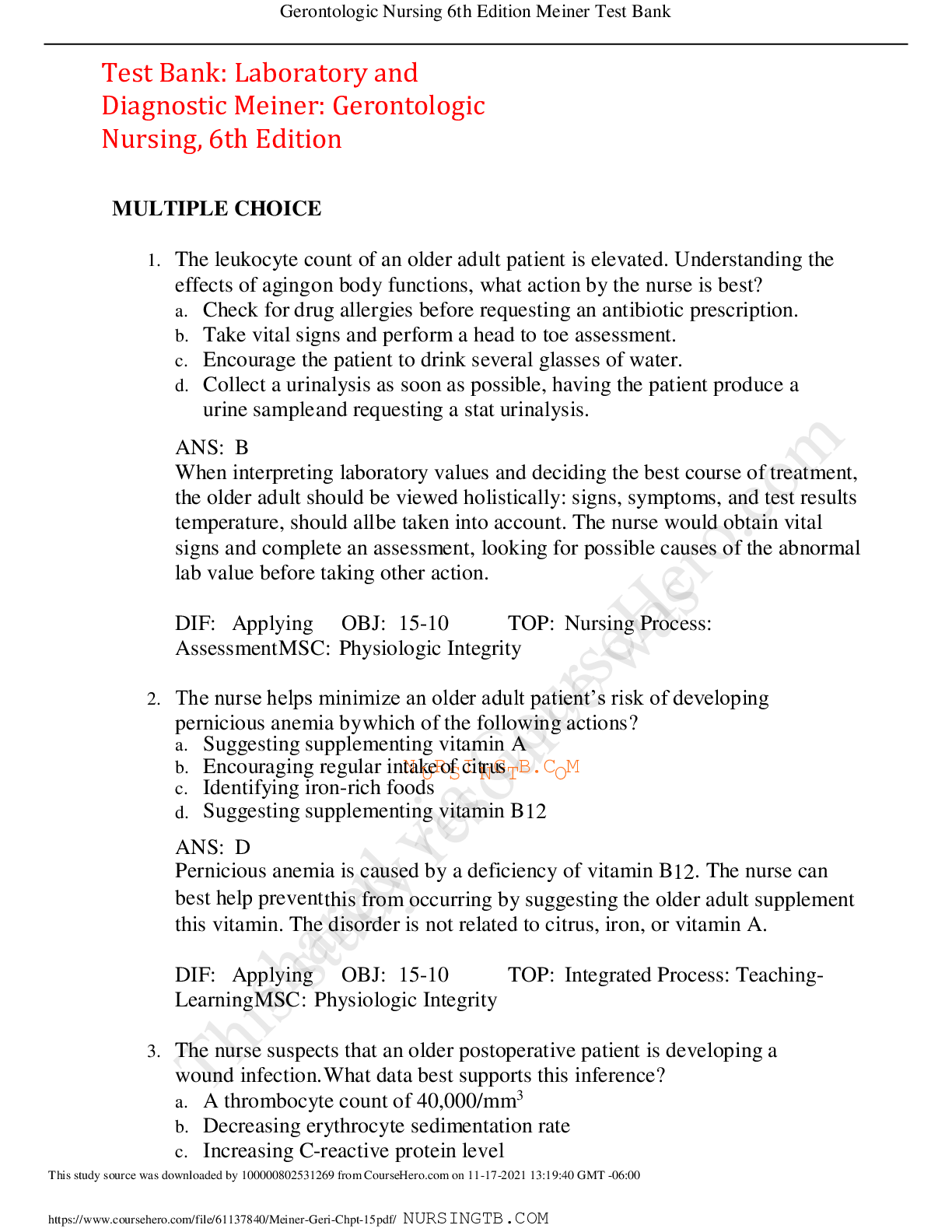


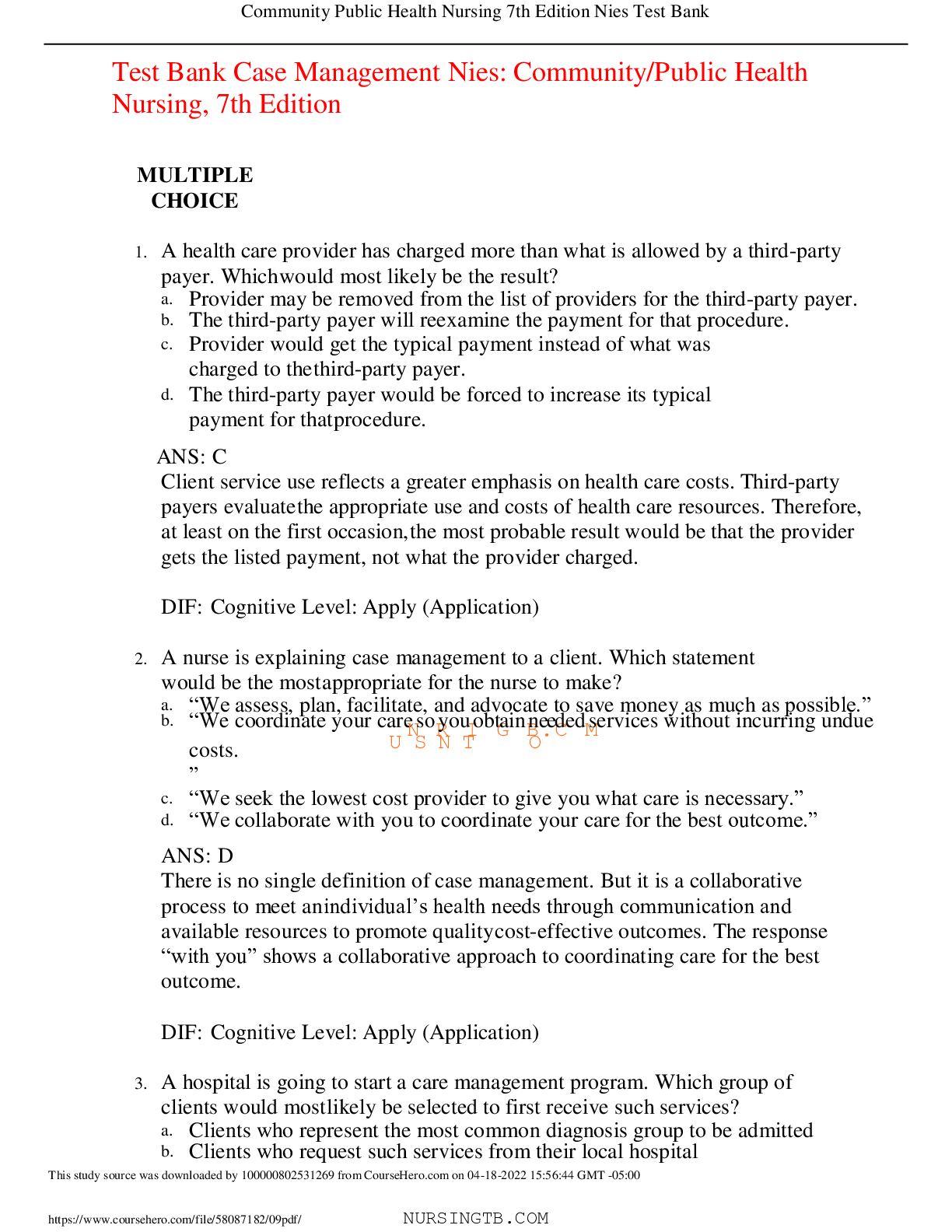


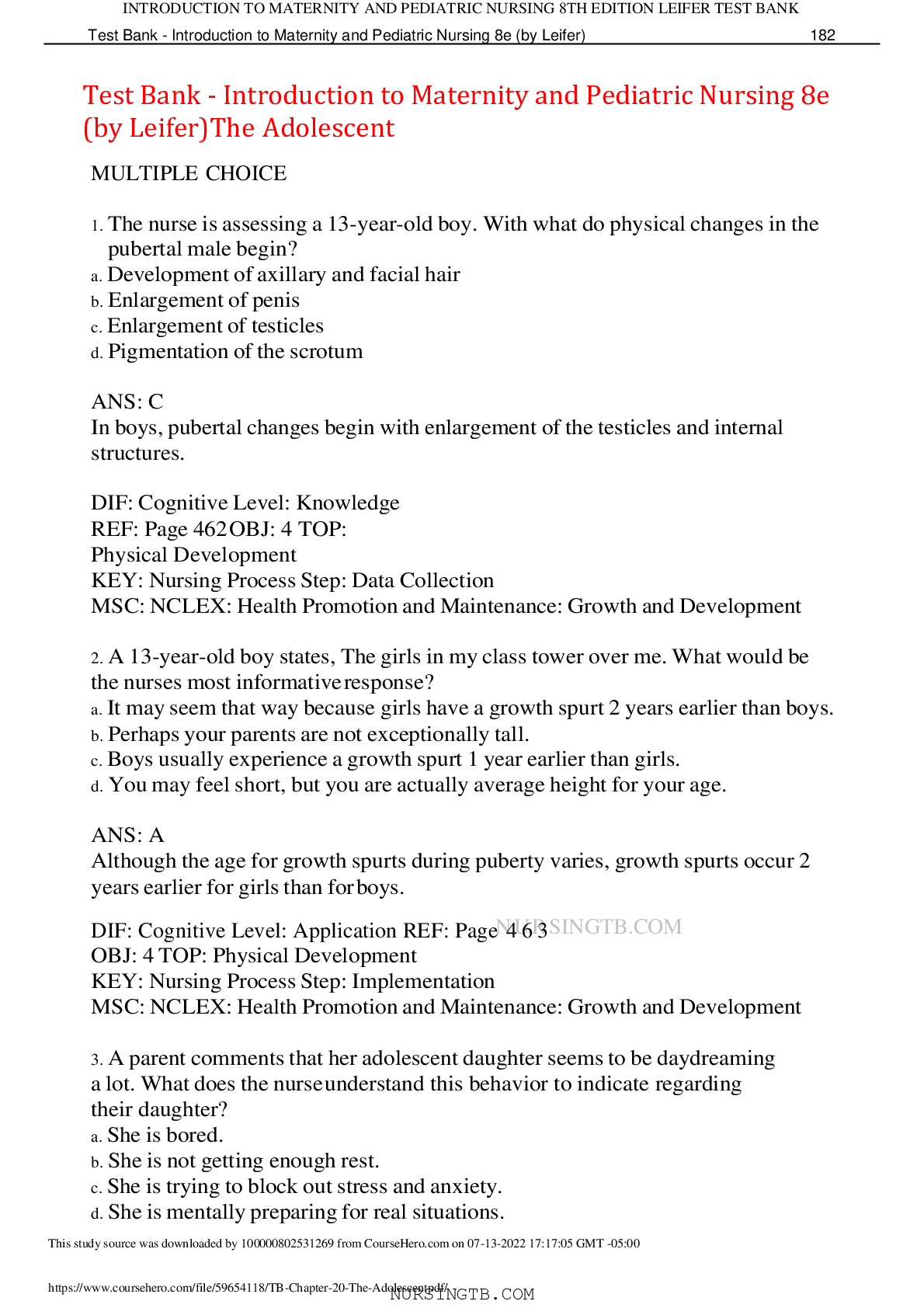



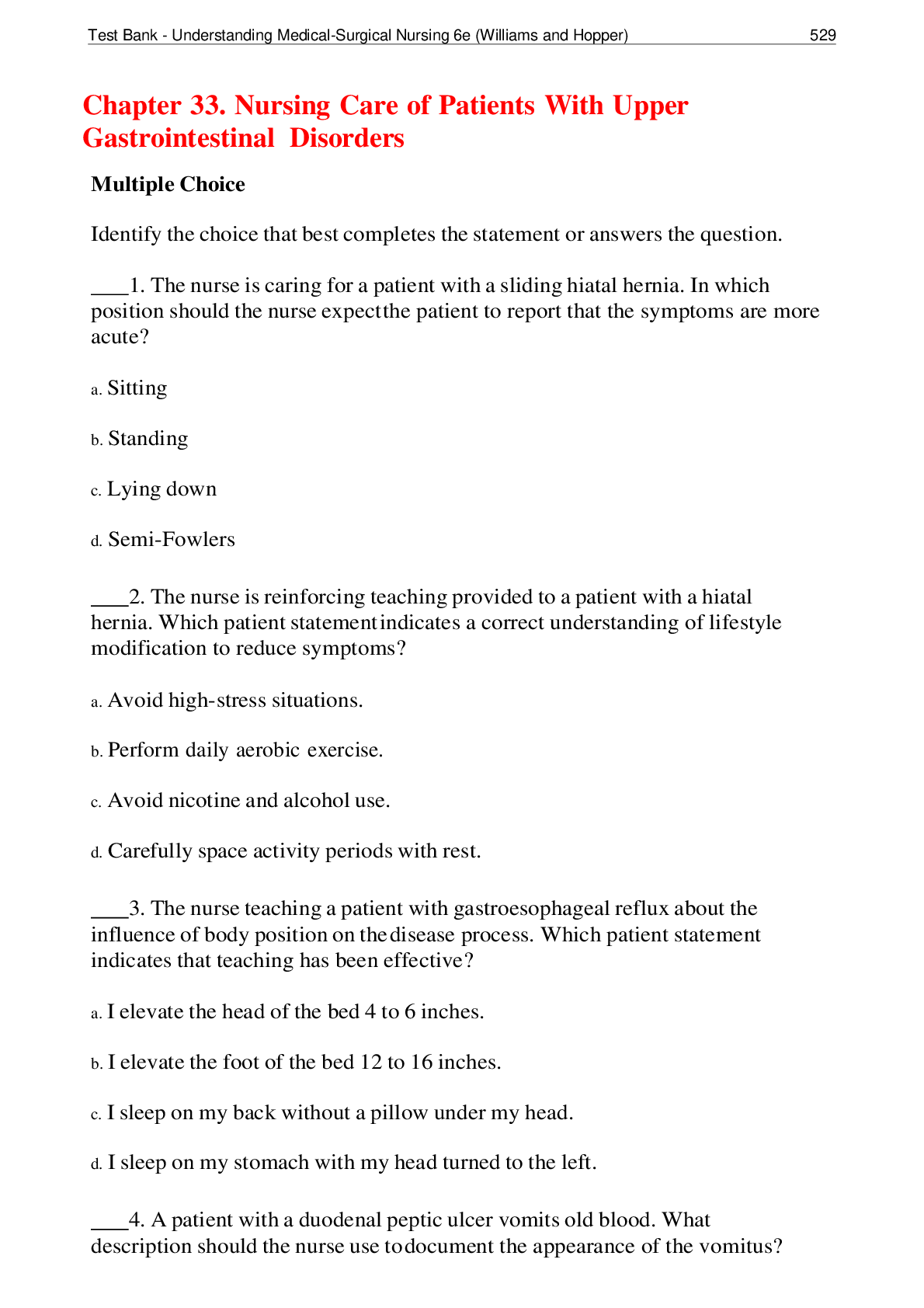
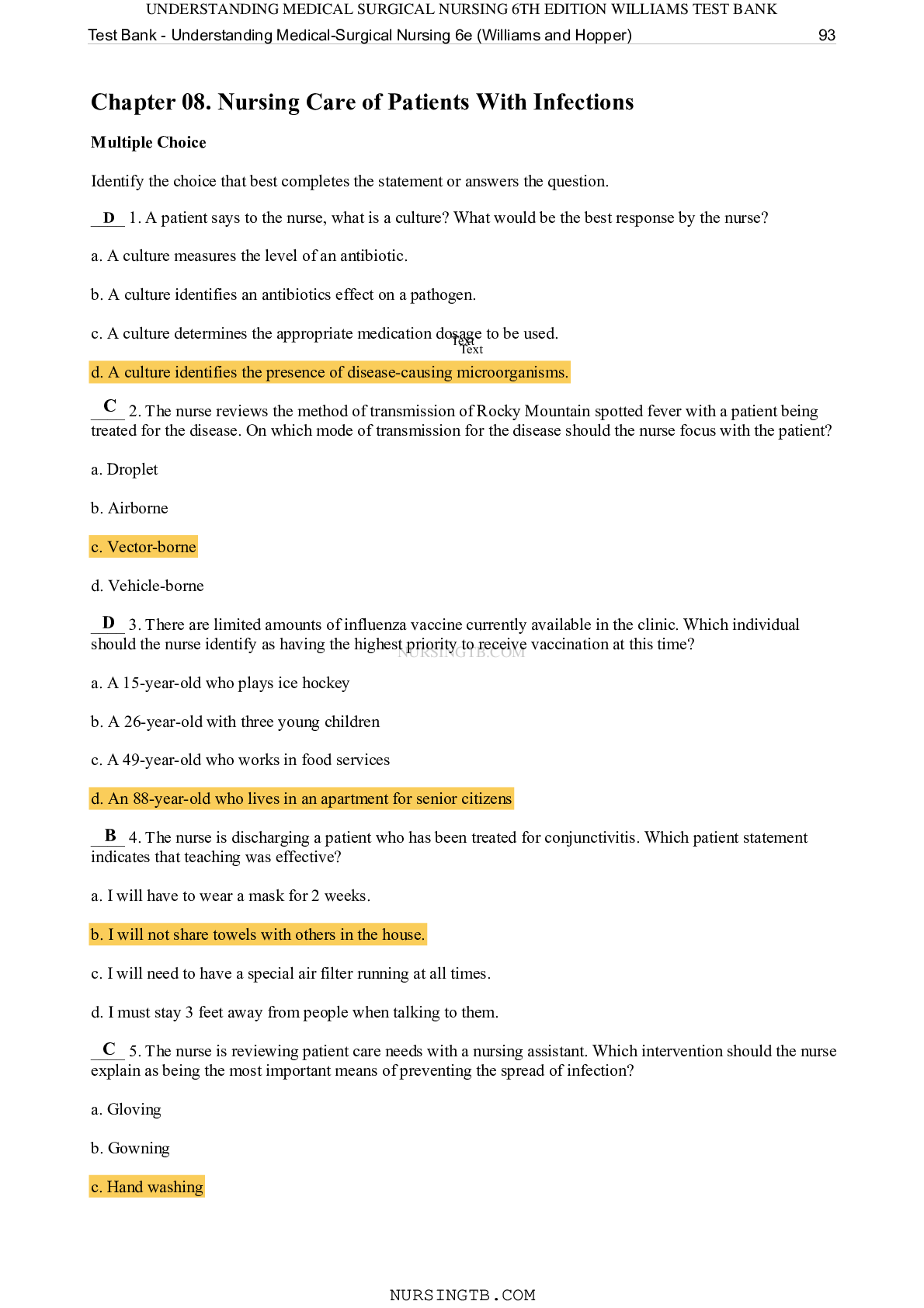

.png)
